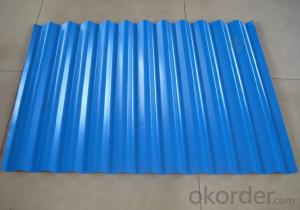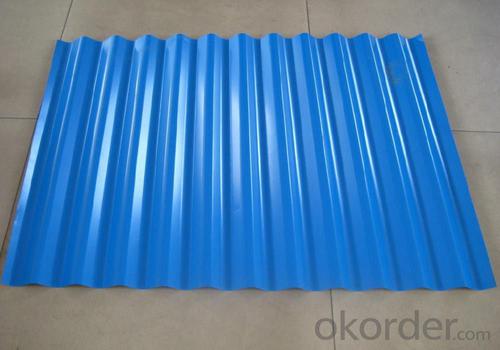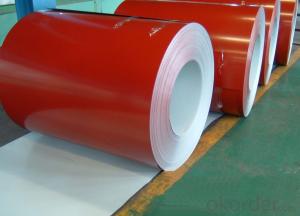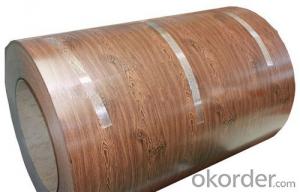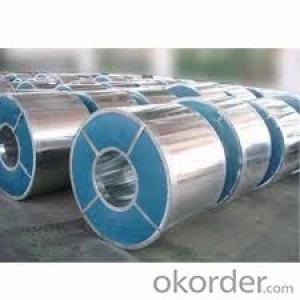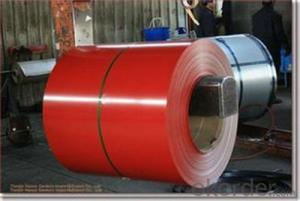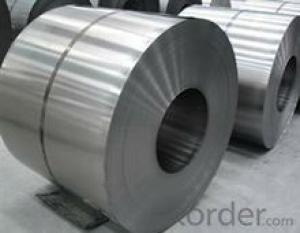color coated galvanized steel Rolled coil
- Loading Port:
- Shanghai
- Payment Terms:
- TT OR LC
- Min Order Qty:
- 30 m.t.
- Supply Capability:
- 300000 m.t./month
OKorder Service Pledge
OKorder Financial Service
You Might Also Like
Specification
Size | Thickness | 0.18-2 mm ,all available . |
Width | 40—1250mm, Steel Strips; 600—1250mm,Steel Sheets. | |
Length | Coil:Ususl weight of coil is 3-8tons Sheet:600-11000mm ,all are available. | |
Standard | AISI,ASTM,GB,JIS,Etc | |
Material | DX51D/52D/53D ;DC01/02/03 | |
MOQ | 20 Tons For Each Size And Each Color | |
Paint Specification | 1. Thickness: ≥20μm 2. Pencil Hardness: 2H 3. 60° specular glossiness of coating: >60 4. 180°bend: ≤3T 5. Impact: ≥9J 6. Salt Fog Resistant: ≥500h 7. Color difference:<0.8δe< span=""> | |
Coil Info | Coil ID | 508/610 mm |
Coil Weight | 3-8 Tons For Each Coil/Sheet | |
Coating (Zinc&Color)
1.Zinc Coating: As usual ,the zinc coating is 50-60g/m2 ,The range will be 40-275g/m2 .
2.Color: Done as the international RAL color chart ,and can also done as customers' color sample .
3.Painting: Front Painting:15-25 μm
Back Painting:5-10 μm
Features of Prepainted Steel Coil :
1) Excellent corrosion resistance: The zinc layer provides a good protection of Pre-painted Galvanizeed Steel Sheet.
2) High heat resistance: The reflective surface of the material aids in efficiently reflecting the sunlight away and in turn reducing the amount of heat transmitted. The thermal reflectivity converts into energy savings.
3) Aesthetics: Pre-Painted Galvanized steel sheet is available in plethora of patterns and multiple sizes as per the requirements that given by our customers.
4) Versatility: can be used in the various areas.
- Q: I understand that damascus sword steel was made by folding the strip of steele double , reheating, hammering, folding again and so forth hundreds of times. Was this the same or very nearly the same techmique the japs used making the sword blades the samari swords?(forgive the misspelling)
- Damascus: A folding technique where the steel is folded over itself many (generally up to sixteen) times, leading to hundreds or even thousands of layers (one fold = 2 layers, two folds = 4 layers, three folds = 8 layers, 16, 32, 64, 128, 256, 512, 1024, 2048, 4096, etc.). More folds than sixteen are pointless, as the layers would become thinner than one molecule - which is impossible. This method was developed to removed impurities from the steel (it also removes carbon, which is bad, but can be compensated for to some degree), but modern steel is so pure that Damascus folding is no longer needed. It is now used for aesthetic reasons; Damascus steel looks really good; you can see the layers in the blade. San Mai: Translates to three layers. Layers of softer, lower carbon steel (or iron) is forge welded to layers of harder, higher carbon steel. The lower carbon steel forms the core (and sometimes the sides and/or back), and the higher carbon steel forms the edge. The hard edge will hold its sharpness, the softer core provides shock absorption; making the sword harder to break. Unlike Damascus, San Mai is still very practical. San Mai folds should be invisible; if you can see a San Mai fold the forging was flawed and the blade should be discarded - you'll have to trust your seller that the blade is San Mai - you can't tell by looking. San Mai can be revealed by etching the blade with acid, such as lemon juice, but I don't recommend trying this unless you know what you're doing; you can permanently stain the blade. San Mai swords are more durable (and more expensive) than simple blades. They are more durable (and usually less expensive) than Damascus blades. A blade can be either San Mai or Damascus, or it can be both; Damascus steel which is then San Mai folded. Very cool, looks good and lasts long.
- Q: How are steel coils inspected for formability using forming tests?
- Steel coils are inspected for formability using forming tests to assess their ability to be shaped into desired forms without any defects or failures. These tests are conducted to evaluate the material's mechanical properties and determine its suitability for specific applications. Forming tests involve subjecting the steel coil to various forming operations, such as bending, deep drawing, or stretch forming. The coil is typically cut into specified dimensions and then subjected to these operations using specialized equipment. The key objective is to simulate the actual forming process that the steel will undergo in real-world applications. During the forming tests, several parameters are closely monitored. These include the amount of force or load applied, the rate of deformation, and the resulting strain or deformation experienced by the steel. Additionally, the coil's response to these operations is observed, including any visible defects like cracks, fractures, or surface imperfections. By carefully analyzing the performance of the steel coil during the forming tests, various formability characteristics can be determined. These include the material's resistance to deformation, its ability to withstand strain without failure, and its tendency to exhibit defects under specific forming conditions. The results obtained from these tests provide valuable insights into the suitability of the steel coil for specific forming processes and applications. Moreover, advanced techniques such as digital image correlation and strain analysis may be employed to precisely measure and evaluate the strain distribution across the steel coil's surface. These techniques help identify regions of the coil that experience higher strain and potential failure points. In conclusion, steel coils are inspected for formability using forming tests that simulate the actual forming processes they will undergo. These tests assess various formability characteristics, including the material's resistance to deformation and its propensity for defects. The results obtained from these tests aid in determining the suitability of the steel coil for specific applications and guide the selection of appropriate forming parameters.
- Q: How are steel coils used in the production of food processing machinery?
- Steel coils are used in the production of food processing machinery as they serve as a key component for constructing the machine's framework and structure. The coils provide durability, strength, and resistance to the machinery, ensuring its reliability and longevity in food processing operations.
- Q: Molten steel changes to solid steel at its __________ point. Could you please fill in the blank? Thank you so much, it is greatly appreciated. I have been looking for the answer to this question for a long time, but I never understand what the websites are trying to say because I don't have that big of a vocabulary and don't know what they mean. I've seen things saying steel boiling point, steel melting point, and steel freezing point. I don't know what any of those mean, and they might be the answer. Please help me. Thank you.
- Kera...time to crank up the brain in gear....molten refers to what state of matter? Solid, Liquid, Gas, Plasma? Ding-Ding-Ding....liquid. Solid to liquid is the melting point.
- Q: What is the thickness of a steel coil?
- The thickness of a steel coil can vary depending on the specific requirements and application. Typically, the thickness of a steel coil can range from a few millimeters to several centimeters.
- Q: What are the common applications of pre-painted galvanized steel coils?
- Pre-painted galvanized steel coils are extensively utilized across various industries due to their wide range of applications. These coils find common usage in the construction industry for roofing, wall cladding, and structural components. Their coating provides exceptional corrosion resistance and durability, making them suitable for both residential and commercial buildings. The automotive industry also heavily relies on these coils for manufacturing body panels, interior trims, and underbody protection. The pre-painted coating not only enhances the aesthetic appeal of vehicles but also provides protection against rust and corrosion. In the production of home appliances, such as refrigerators, ovens, washing machines, and air conditioners, pre-painted galvanized steel coils are commonly employed. The smooth and durable coating ensures a long-lasting and visually appealing finish for these appliances. The furniture industry also benefits from using pre-painted galvanized steel coils, which are used for manufacturing cabinets, shelves, and other furniture components. The coating on these coils adds a decorative element while offering protection against scratches and wear. In the electrical and electronics industry, pre-painted galvanized steel coils are utilized for manufacturing switchboards, control panels, and enclosures. The pre-painted coating provides insulation and protection against electrical hazards, making them suitable for such applications. In the agricultural sector, these coils are used for manufacturing equipment like grain silos, livestock shelters, and poultry houses. The corrosion-resistant coating ensures the durability and longevity of these agricultural structures. The vibrant and visually appealing colors of pre-painted galvanized steel coils make them a popular choice for signage and advertisement boards. The coated surface provides a smooth and glossy finish that enhances the visibility and attractiveness of the signage. To summarize, pre-painted galvanized steel coils offer excellent corrosion resistance, durability, and aesthetic appeal, making them suitable for a wide range of industries and applications, including construction, automotive, appliances, furniture, electrical and electronics, agricultural equipment, and signage and advertisement.
- Q: I am looking at website on google based on the terms structural steel fabrication and simply steel fabricationI know that there must be a difference between the two terms, but it seems that many website authors use the two terms interchangeably.Do you know the key differences between the two terms?
- Steel fabrication can include any kind of manufacture of steel. Structural steel is a narrow subset which would include, for example, I-beams and would not usually include stainless steel, sheet steel, rolled steel, etc.
- Q: How are steel coils used in the manufacturing of railway tracks?
- Steel coils are used in the manufacturing of railway tracks as they are processed into long, continuous lengths of steel rails. These coils are first uncoiled and then passed through a series of machines that shape, cut, and weld them together to form the required lengths and profiles of railway tracks.
- Q: I just want to know why is cold steel katana a very good sword?? How can you tell if a cold steel katana is good or not
- Cold Steel makes the best and strongest swords around, ever cut through a steel car hood? Their swords can, I would suggest that if you but one, to also get yourself some life insurance... these things are incredible.
- Q: Where can I find a great deal online for Danesco Stainless Steel Egg Poacher
- Cheapest place to buy Danesco Stainless Steel Egg Poacher is amazon, and the price is $34.99. For more information check the link below....
Send your message to us
color coated galvanized steel Rolled coil
- Loading Port:
- Shanghai
- Payment Terms:
- TT OR LC
- Min Order Qty:
- 30 m.t.
- Supply Capability:
- 300000 m.t./month
OKorder Service Pledge
OKorder Financial Service
Similar products
Hot products
Hot Searches
Related keywords
